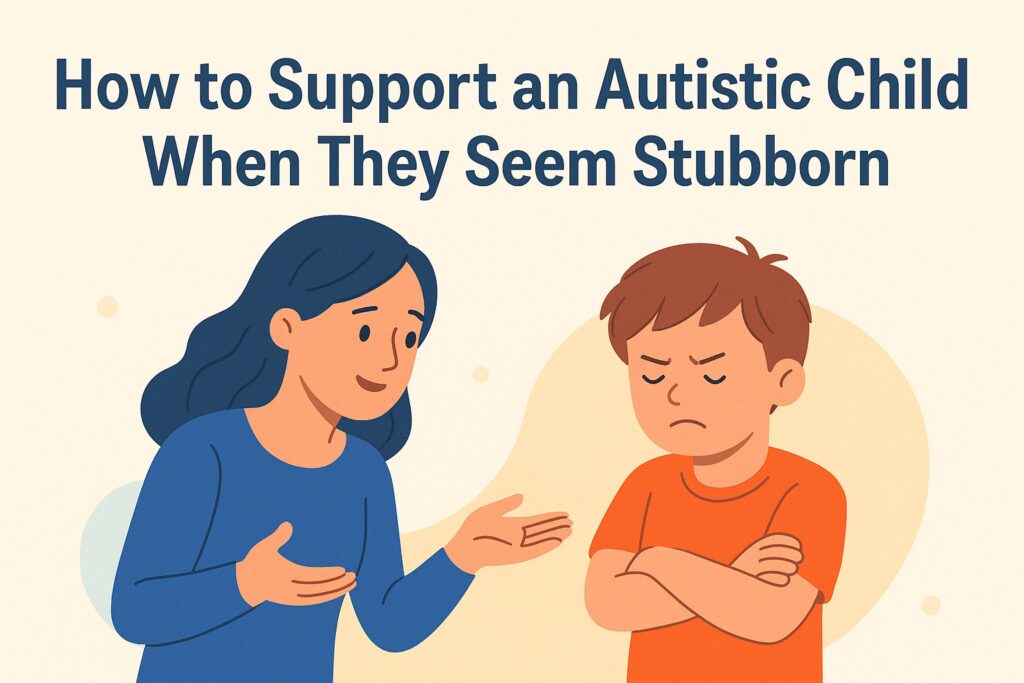
The other day, a mom in my clinic shared a familiar scene:
“We were already late for school. My son refused to put on his shoes because they didn’t feel right. I tried reasoning, I tried hurrying him along, but the more I pushed, the more he shut down. Finally, he was on the floor crying, and I felt like crying too. It wasn’t about the shoes anymore—it was about both of us feeling stuck.”
If you’re parenting an autistic child, this might sound familiar. What looks like “stubbornness” often shows up in daily routines—getting dressed, leaving the house, switching off screens. These moments can feel like brick walls.
But here’s what I tell families: stubborn behavior is rarely about defiance. It’s about communication, stress, and a child trying to cope with a world that feels unpredictable or overwhelming. And when we understand the “why,” we can respond with calm, compassionate strategies that make a real difference.
The guiding principle? Understanding first, then action.
Why “Stubborn” Behavior Happens in Autism
Rigid or resistant behavior—what I sometimes jokingly call “sticky brain syndrome”—is often a child’s way of coping. Instead of being oppositional, it reflects deeper challenges such as:
- Anxiety: New situations or unexpected changes feel threatening.
- Sensory overload: Lights, sounds, textures, or emotions overwhelm the nervous system.
- Executive functioning struggles: Shifting gears, planning, or problem-solving is harder.
- Need for predictability: Routines help a child feel safe and in control.
When parents start to see stubbornness as communication instead of defiance, everything shifts.
Step 1: Regulate Yourself First
Before you can help your child calm down, you need to steady yourself. Kids are sensitive to our emotional states.
Try:
- Pausing for a few deep breaths.
- Lowering your voice instead of raising it.
- Relaxing your posture.
- Reminding yourself: “This is harder for them than it is for me. My calm helps.”
Unless safety is at risk, avoid ultimatums. Lead with connection, not control.
Step 2: Validate Their Feelings
Validation means saying, “I see you, and what you’re feeling is real.”
Try:
- “This change is hard for you. I get it.”
- “You’re upset because things feel different. That makes sense.”
- “It’s okay to be frustrated. I’m here with you.”
Avoid dismissive phrases like “calm down” or “stop it,” which often backfire.
Step 3: Use Visuals and Predictable Supports
Structure helps ease anxiety and resistance.
- Visual schedules: Break the day into clear steps.
- First–then boards: “First brush teeth, then play.”
- Social stories: Simple, personalized stories that explain expectations.
- Timers: Make transitions more predictable by showing start and end times.
Step 4: Offer Choices for Autonomy
Many meltdowns come from feeling powerless. Choices restore a sense of control.
Examples:
- “Do you want the blue shirt or the red one?”
- “Sit at the table or the island?”
- “Do you want to buckle your seatbelt, or should I?”
Even small choices can prevent big struggles.
Step 5: Be Consistent—But Flexible
Children thrive with routine, but life isn’t always predictable. Balance helps:
- Keep core routines steady (bedtime, meals).
- When changes happen, explain clearly: “The power went out because of the storm. Remember what we do? We grab flashlights and get cozy.”
- Be willing to shift strategies—what works one day might not work the next.
Step 6: Practice Calming Techniques
Help your child discover what soothes them, and practice when they’re calm.
Options include:
- Sensory tools: Weighted blankets, fidgets, headphones.
- Movement: Swinging, stretching, pacing.
- Mindfulness: Breathing, body scans, guided imagery.
- Safe spaces: A quiet, cozy corner at home.
Build a “calm-down kit” together so strategies are always available.
Step 7: Reflect and Reconnect
After the hard moment passes, take time to repair and learn.
- Highlight effort: “You worked hard to calm your body.”
- Ask gently: “What helped you feel better? What should we try next time?”
- Reassure connection: “I love you. I’m proud of how you’re trying.”
These reflections strengthen resilience and your relationship.
Step 8: Seek Support
Parenting an autistic child can feel isolated, but you’re not alone.
- Therapists can offer personalized strategies.
- Parent groups provide encouragement and shared wisdom.
- Training programs give practical tools that work.
Compassion First, Always
When your autistic child seems “stubborn,” remember—it’s not defiance, it’s communication. Your calm presence, steady routines, and compassionate responses are powerful tools.
I often remind parents: your child is doing the best they can with the tools they have. And so are you.
Together, with patience and understanding, you can turn moments of resistance into opportunities for connection and growth.
